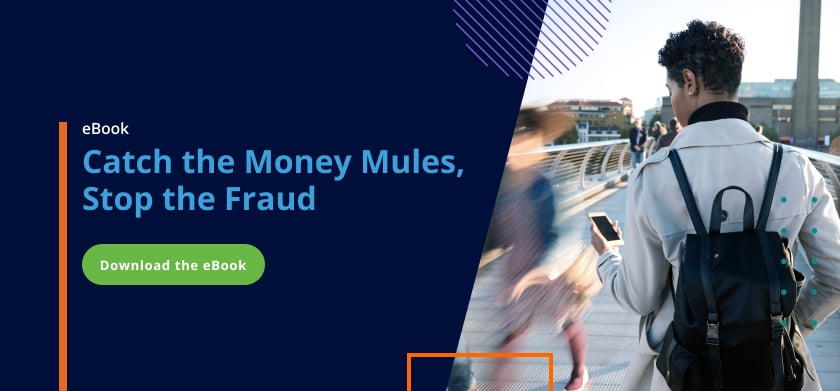New Regulations Call for a Money Mule Detection Blueprint
Money mules come in many forms. They can be:
- Purposely open money mule accounts: bank accounts opened by individuals who knowingly collaborate in fraud or criminal schemes;
- Unwitting money mules: individuals lured into a mule scheme by various scam techniques. These include fake job listings, romance scams, investment scams, or other deceptions; or
- Witting money mules: individuals who intentionally engage in illegal activity, often due to financial strain or the promise of easy money.
Whatever their motivation, they are essential to helping criminals profit from fraud, scams, and money laundering.
Feedzai’s research sheds light on the severity of the money mule challenge. A comprehensive survey of over 4,000 participants in the United Kingdom and the United States found that 66% of respondents between ages 25 and 34 said they were targeted as money mules.
The push for a blueprint to uncover mule account activity comes as banks face increased pressure to reimburse scam losses. Starting in 2024, the UK’s Payment Systems Regulator (PSR) will require UK banks to reimburse scam victims with liability split 50-50 between sending and receiving banks.
With the diversity of money mule activities and the increasing accountability under PSR’s new scheme, finding innovative ways to identify money mule activity is crucial. To that end, Feedzai recently hosted a roundtable discussion, bringing together industry experts to explore strategic opportunities for financial institutions to bolster their money mule detection capabilities.
The discussion revolved around essential recommendations to fortify the financial service industry’s response to the money mule threat. Ultimately, participants crafted a blueprint for money mule detection that will be critical to stopping money mules and financial crime.
7 Keys to a Money Mule Detection Blueprint
An effective mule detection blueprint includes several important factors. These include:
1. Strengthen Account Opening Controls
Banks should review and validate their account opening controls, ensuring they are both effective and up-to-date to bolster initial defenses against fraudulent transactions and activities. Although not foolproof, this step provides an opportunity to strengthen the first line of defense against money mules.
2. Propensity Modeling
Banks can develop an ongoing mule risk propensity score by monitoring accounts for subtle changes in user behavior. This approach enables a better understanding of overall mule exposure, informing future risk decisions and improving mule account detection. For instance, indicators of recent financial distress, like sudden overdraft usage, may signal a legitimate customer faces higher susceptibility to mule coercion or recruitment. Ongoing propensity modeling allows the bank to get ahead of the mule threat and often capture money mules before they receive fraudulent funds.
3. Inbound Payment Monitoring
Real-time monitoring of inbound payments emerged as a cornerstone in a robust mule detection strategy, especially in light of the UK PSR’s liability model. While a robust control, this approach requires addressing operational capacity and user treatment issues to be truly transformative.
4. Tying Decisions and Data Together
Ensuring the interconnectedness of various fraud decisioning systems provides a comprehensive view of customer transactional patterns. This holistic understanding aids in detecting cross-channel mule activities, for example, using risk signals from account opening throughout the customer lifecycle or using digital events to influence future card payment decisions
5. Network Value
Exploring network-level views from financial services providers offers unique perspectives to detect payments across multiple financial institutions. Combining these views with existing fraud strategies has demonstrated significant incremental value, providing insights that individual banks might otherwise miss.
6. Link Analysis
Rather than focusing solely on individual mule accounts, banks should focus on uncovering relationships through link analysis. Tracking funds transfers, shared devices, IP addresses, and more can lead to the identification of mule networks, facilitating broader takedown actions.
7. Enhanced Mule Education
Adopting a successful scam awareness and education approach, banks should invest in mule risk education from an early age through university. Integrating data-driven signals for timely and engaging warnings in the user journey can further enhance mule risk awareness.
3 Future Industry Considerations to Fight Money Mules
Roundtable participants also shared ideas on future industry steps to combat money mules. These
1. Leveraging External Data Sources
Considering external data sources, including social media signals, was suggested to detect mule risks. Social media data, such as anonymized messages on platforms like Meta, could serve as valuable features in real-time mule risk assessments, though the discussions around this are still evolving.
2. Payment Risk Flags within Faster Payment Message
Evaluating the feasibility of including payment red flags within the UK’s Faster Payment scheme, similar to the Netherlands, was proposed. These flags, provided by the sending bank, can enhance inbound payment monitoring for the receiving bank.
3. Payment Delays
Introducing payment delays for users with a high risk of being money mules was also explored. This “cooling-off” period may offer an opportunity for the bank to take evasive action in case of suspicious activities. However, the approach carries both pros and cons and requires further debate.
Feedzai’s roundtable discussion underscored the need for a comprehensive and standardized approach to detect money mules. The financial industry can better protect itself from the pervasive money mules threat by addressing these critical areas.
Share this article:
Daniel Holmes
Dan Holmes is a fraud prevention subject matter expert at Feedzai. He has worked in the fraud domain for over 10 years and strategizes product direction in line with future market trends and collaborates globally with banks on a variety of fraud challenges. Dan covers a wide range of topics, including fraud risks, fraud technology, and shifting regulations.
Related Posts
0 Comments4 Minutes
Feedzai’s AI Technology Earns Industry Recognition by Chartis
Feedzai, the world’s first RiskOps platform, has secured a pair of critical recognitions…
0 Comments6 Minutes
10 Fraud Prevention Tips for Businesses
Hopefully, you’ve had a chance to read Feedzai’s James Hunt’s insightful conversation…
0 Comments7 Minutes
Beyond the Face: Why Vietnam’s Banks Need Behavioral Biometrics to Fight the Rising Tide of Fraud
Financial transactions are increasingly virtual in today’s digital age, making fraud…

